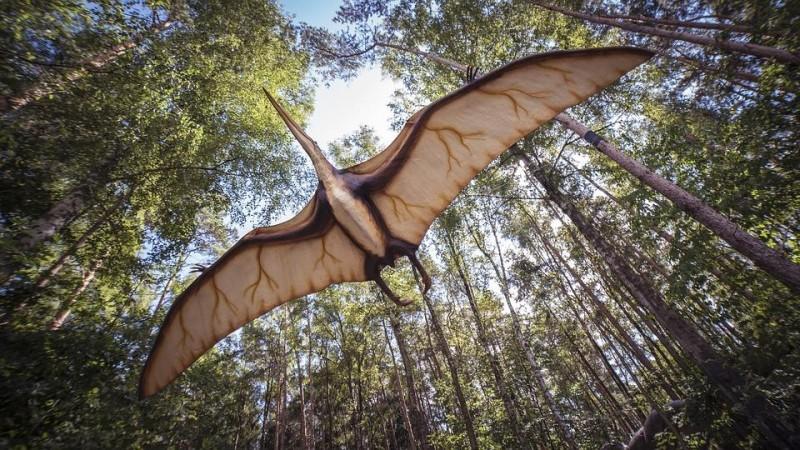For those who grew up with the Jurassic Park franchise, one may remember pterosaurs as the flying terrors of the sky. These prehistoric air-borne reptiles flew over their reptilian ground-dwelling cousins and were known for their long bills and elongated wings. Nevertheless, it is has remained uncertain whether pterosaur hatchlings were capable of flight. Now, a new study has stated that newly-hatched pterosaurs may have been capable of flight; however, their flying capabilities may have been very different from adult pterosaurs.
The study by paleontologists from multiple institutions found that the humerus bones of hatchlings were stronger than that of several adult pterosaurs. This suggested that they may have been powerful enough to fly. The study was published in the journal Scientific Reports.
"There have been several debates about whether juvenile pterosaurs could fly, but this is the first time it's been studied through a more biomechanical point of view. It's exciting to discover that even though their wings may have been small, they were built in a way that made them strong enough to fly," said Dr. Elizabeth Martin-Silverstone, co-author of the study, in a statement.
Understanding Hatchling Flight

Pterosaurs thrived during the Triassic, Jurassic and Cretaceous Periods—around 228 to 66 million years ago. They are believed to be one of the earliest vertebrates to have evolved the ability of powered flight. Along with fossilized pterosaur eggs and embryos being rare, and challenges associated with differentiating between hatchlings and small adults, the question of whether newly-hatched pterosaurs were capable of flight has remained largely unanswered.
For the study, the flying capabilities of hatchlings were modeled using previously acquired measurements of wings from four confirmed and hatchling and embryo fossils belonging to two species of petrosausrs—Pterodaustro guinazui and Sinopterus dongi. These wing measurements were compared to those of adults within the same species. Also, the strength of a crucial bone in the wing, the humerus bone, of three hatchlings was compared with that of 22 adult pterosaurs.
"Although we've known about pterosaurs for over two centuries, we've only had fossils of their embryos and hatchlings since 2004. We're still trying to understand the early stages of life in these animals. One discussion has centred around whether pterosaurs could fly as hatchlings or, like the vast majority of birds and bats, they had to grow a little before they could take wing," explained Dr. Mark Witton, co-author of the study.
Different from Adult Flight

It was found that though the hatchlings possessed long and narrow wings that were suited for long-distance flight, they were broader and shorter than those of adults who were hundreds of times larger. Relative to their mass and body size, they had larger wing areas. Thus, these measurements, despite making the hatchlings less effective than their parents when it came to long-distance journeys, may have made them more nimble fliers.
They would have been able to change speed and direction swiftly. "We found that these tiny animals -- with 25 cm wingspans and bodies that could neatly fit in your hand -- were very strong, capable fliers. Their bones were strong enough to sustain flapping and take-off, and their wings were ideally shaped for powered (as opposed to gliding) flight," stated Dr. Witton.
Advantages of Smaller Bodies

However, being less efficient fliers than fully grown adults may have come with its own set advantages the authors speculated. According to them, the agile style of flight may have enabled hatchlings to evade predators and equipped them better to pursue more limber prey. When compared to adult pterosaurs, they would also have been able to fly more easily among dense vegetation.
"That gives us a lot to think about with regard to flying reptile ecology. How independent were the hatchlings from their parents? Did flight style influence habitat choices, and did these change as pterosaurs grew? There's still a lot to learn about the life histories of these animals, but we're confident that, whatever they were doing as they grew up, they were capable of flying from the moment they hatched," concluded Dr. Witton.












!['Had denied Housefull franchise as they wanted me to wear a bikini': Tia Bajpai on turning down bold scripts [Exclusive]](https://data1.ibtimes.co.in/en/full/806605/had-denied-housefull-franchise-they-wanted-me-wear-bikini-tia-bajpai-turning-down-bold.png?w=220&h=138)
![Nayanthara and Dhanush ignore each other as they attend wedding amid feud over Nayanthara's Netflix documentary row [Watch]](https://data1.ibtimes.co.in/en/full/806599/nayanthara-dhanush-ignore-each-other-they-attend-wedding-amid-feud-over-nayantharas-netflix.jpg?w=220&h=138)



